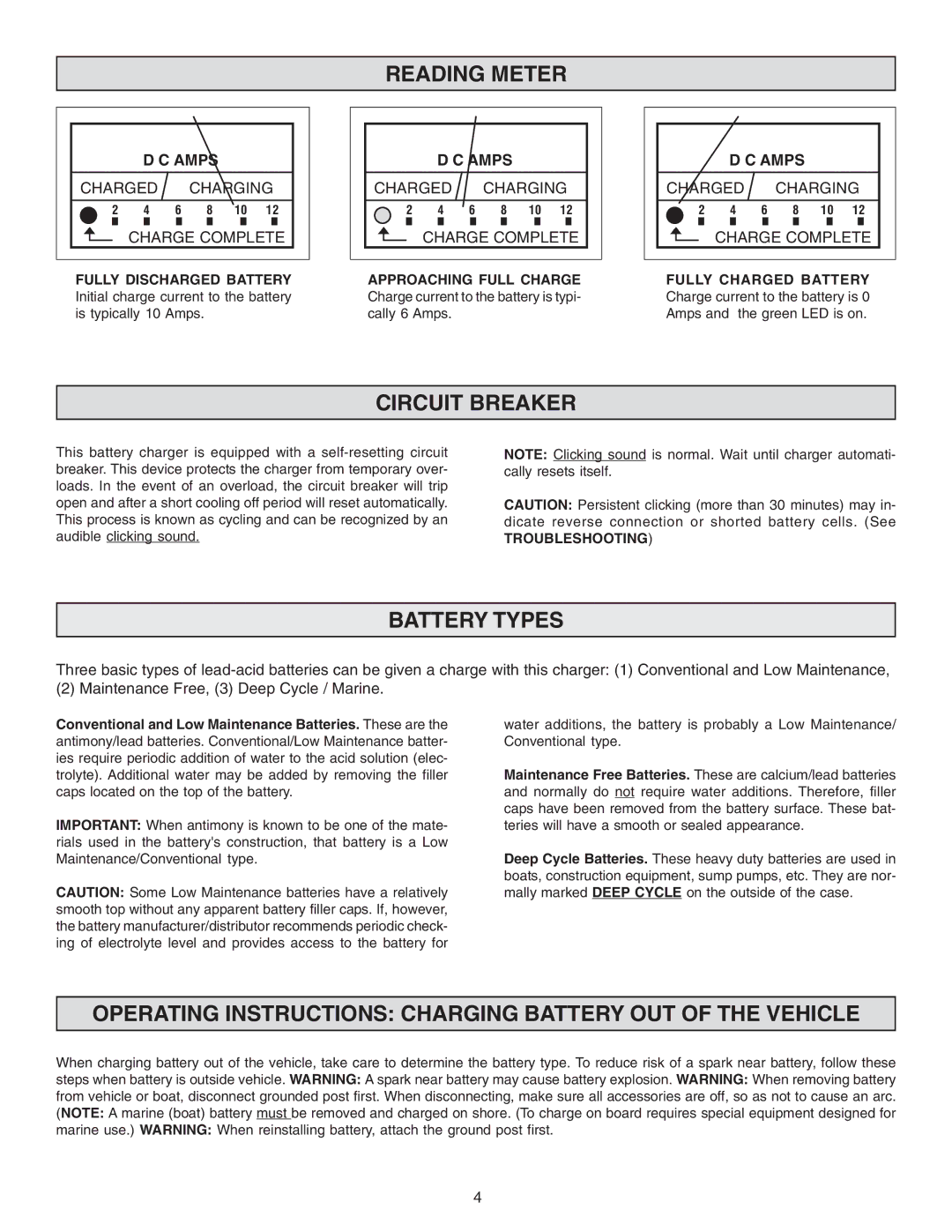
READING METER
| D C AMPS |
|
| ||
CHARGED |
| CHARGING | |||
2 | 4 | 6 | 8 | 10 | 12 |
| CHARGE COMPLETE | ||||
FULLY DISCHARGED BATTERY Initial charge current to the battery is typically 10 Amps.
| D C AMPS |
|
| ||
CHARGED |
| CHARGING | |||
2 | 4 | 6 | 8 | 10 | 12 |
| CHARGE COMPLETE | ||||
APPROACHING FULL CHARGE Charge current to the battery is typi- cally 6 Amps.
| D C AMPS |
|
| ||
CHARGED |
| CHARGING | |||
2 | 4 | 6 | 8 | 10 | 12 |
| CHARGE COMPLETE | ||||
FULLY CHARGED BATTERY Charge current to the battery is 0 Amps and the green LED is on.
CIRCUIT BREAKER
This battery charger is equipped with a
NOTE: Clicking sound is normal. Wait until charger automati- cally resets itself.
CAUTION: Persistent clicking (more than 30 minutes) may in- dicate reverse connection or shorted battery cells. (See
TROUBLESHOOTING)
BATTERY TYPES
Three basic types of
(2) Maintenance Free, (3) Deep Cycle / Marine.
Conventional and Low Maintenance Batteries. These are the antimony/lead batteries. Conventional/Low Maintenance batter- ies require periodic addition of water to the acid solution (elec- trolyte). Additional water may be added by removing the filler caps located on the top of the battery.
IMPORTANT: When antimony is known to be one of the mate- rials used in the battery's construction, that battery is a Low Maintenance/Conventional type.
CAUTION: Some Low Maintenance batteries have a relatively smooth top without any apparent battery filler caps. If, however, the battery manufacturer/distributor recommends periodic check- ing of electrolyte level and provides access to the battery for
water additions, the battery is probably a Low Maintenance/ Conventional type.
Maintenance Free Batteries. These are calcium/lead batteries and normally do not require water additions. Therefore, filler caps have been removed from the battery surface. These bat- teries will have a smooth or sealed appearance.
Deep Cycle Batteries. These heavy duty batteries are used in boats, construction equipment, sump pumps, etc. They are nor- mally marked DEEP CYCLE on the outside of the case.
OPERATING INSTRUCTIONS: CHARGING BATTERY OUT OF THE VEHICLE
When charging battery out of the vehicle, take care to determine the battery type. To reduce risk of a spark near battery, follow these steps when battery is outside vehicle. WARNING: A spark near battery may cause battery explosion. WARNING: When removing battery from vehicle or boat, disconnect grounded post first. When disconnecting, make sure all accessories are off, so as not to cause an arc. (NOTE: A marine (boat) battery must be removed and charged on shore. (To charge on board requires special equipment designed for marine use.) WARNING: When reinstalling battery, attach the ground post first.
4
